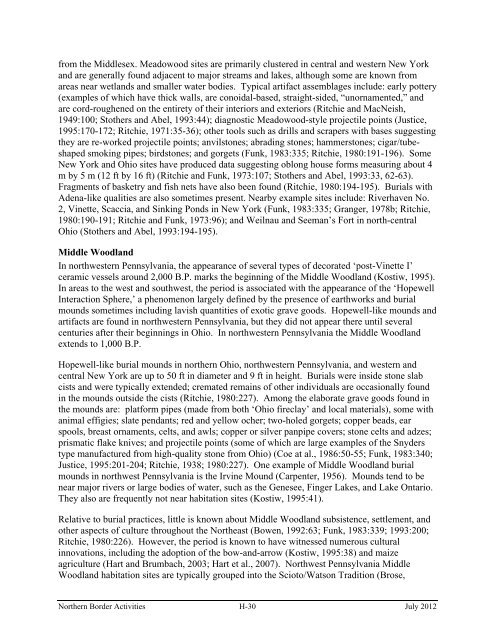Appendix H - Historical Archaeological and ... - CBP.gov
Appendix H - Historical Archaeological and ... - CBP.gov
Appendix H - Historical Archaeological and ... - CBP.gov
You also want an ePaper? Increase the reach of your titles
YUMPU automatically turns print PDFs into web optimized ePapers that Google loves.
from the Middlesex. Meadowood sites are primarily clustered in central <strong>and</strong> western New York<br />
<strong>and</strong> are generally found adjacent to major streams <strong>and</strong> lakes, although some are known from<br />
areas near wetl<strong>and</strong>s <strong>and</strong> smaller water bodies. Typical artifact assemblages include: early pottery<br />
(examples of which have thick walls, are conoidal-based, straight-sided, “unornamented,” <strong>and</strong><br />
are cord-roughened on the entirety of their interiors <strong>and</strong> exteriors (Ritchie <strong>and</strong> MacNeish,<br />
1949:100; Stothers <strong>and</strong> Abel, 1993:44); diagnostic Meadowood-style projectile points (Justice,<br />
1995:170-172; Ritchie, 1971:35-36); other tools such as drills <strong>and</strong> scrapers with bases suggesting<br />
they are re-worked projectile points; anvilstones; abrading stones; hammerstones; cigar/tubeshaped<br />
smoking pipes; birdstones; <strong>and</strong> gorgets (Funk, 1983:335; Ritchie, 1980:191-196). Some<br />
New York <strong>and</strong> Ohio sites have produced data suggesting oblong house forms measuring about 4<br />
m by 5 m (12 ft by 16 ft) (Ritchie <strong>and</strong> Funk, 1973:107; Stothers <strong>and</strong> Abel, 1993:33, 62-63).<br />
Fragments of basketry <strong>and</strong> fish nets have also been found (Ritchie, 1980:194-195). Burials with<br />
Adena-like qualities are also sometimes present. Nearby example sites include: Riverhaven No.<br />
2, Vinette, Scaccia, <strong>and</strong> Sinking Ponds in New York (Funk, 1983:335; Granger, 1978b; Ritchie,<br />
1980:190-191; Ritchie <strong>and</strong> Funk, 1973:96); <strong>and</strong> Weilnau <strong>and</strong> Seeman’s Fort in north-central<br />
Ohio (Stothers <strong>and</strong> Abel, 1993:194-195).<br />
Middle Woodl<strong>and</strong><br />
In northwestern Pennsylvania, the appearance of several types of decorated ‘post-Vinette I’<br />
ceramic vessels around 2,000 B.P. marks the beginning of the Middle Woodl<strong>and</strong> (Kostiw, 1995).<br />
In areas to the west <strong>and</strong> southwest, the period is associated with the appearance of the ‘Hopewell<br />
Interaction Sphere,’ a phenomenon largely defined by the presence of earthworks <strong>and</strong> burial<br />
mounds sometimes including lavish quantities of exotic grave goods. Hopewell-like mounds <strong>and</strong><br />
artifacts are found in northwestern Pennsylvania, but they did not appear there until several<br />
centuries after their beginnings in Ohio. In northwestern Pennsylvania the Middle Woodl<strong>and</strong><br />
extends to 1,000 B.P.<br />
Hopewell-like burial mounds in northern Ohio, northwestern Pennsylvania, <strong>and</strong> western <strong>and</strong><br />
central New York are up to 50 ft in diameter <strong>and</strong> 9 ft in height. Burials were inside stone slab<br />
cists <strong>and</strong> were typically extended; cremated remains of other individuals are occasionally found<br />
in the mounds outside the cists (Ritchie, 1980:227). Among the elaborate grave goods found in<br />
the mounds are: platform pipes (made from both ‘Ohio fireclay’ <strong>and</strong> local materials), some with<br />
animal effigies; slate pendants; red <strong>and</strong> yellow ocher; two-holed gorgets; copper beads, ear<br />
spools, breast ornaments, celts, <strong>and</strong> awls; copper or silver panpipe covers; stone celts <strong>and</strong> adzes;<br />
prismatic flake knives; <strong>and</strong> projectile points (some of which are large examples of the Snyders<br />
type manufactured from high-quality stone from Ohio) (Coe at al., 1986:50-55; Funk, 1983:340;<br />
Justice, 1995:201-204; Ritchie, 1938; 1980:227). One example of Middle Woodl<strong>and</strong> burial<br />
mounds in northwest Pennsylvania is the Irvine Mound (Carpenter, 1956). Mounds tend to be<br />
near major rivers or large bodies of water, such as the Genesee, Finger Lakes, <strong>and</strong> Lake Ontario.<br />
They also are frequently not near habitation sites (Kostiw, 1995:41).<br />
Relative to burial practices, little is known about Middle Woodl<strong>and</strong> subsistence, settlement, <strong>and</strong><br />
other aspects of culture throughout the Northeast (Bowen, 1992:63; Funk, 1983:339; 1993:200;<br />
Ritchie, 1980:226). However, the period is known to have witnessed numerous cultural<br />
innovations, including the adoption of the bow-<strong>and</strong>-arrow (Kostiw, 1995:38) <strong>and</strong> maize<br />
agriculture (Hart <strong>and</strong> Brumbach, 2003; Hart et al., 2007). Northwest Pennsylvania Middle<br />
Woodl<strong>and</strong> habitation sites are typically grouped into the Scioto/Watson Tradition (Brose,<br />
Northern Border Activities H-30 July 2012
















